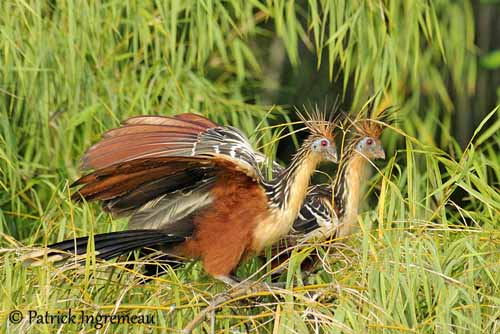

DESCRIPTION FAMILY OPISTHOCOMIDAE
The Hoatzin, after several passages thought several Orders such as Galliformes and Coliiformes, has also been classified in the Cuculiformes from which it differs by typical, non-zygodactyls toes.
It also presents some resemblance with the ancient feathered dinosaur Archaeopteryx.
Other sources IOC World Bird Names place this species in its own order Opisthocomiformes, and its own family, Opisthocomidae of which it is the unique member. Actually, any bird species appears closely related to this bird.
The Hoatzin is a stunning colourful bird from North of South America. Its long feathered crest permanently erected gives this bird an elegant silhouette, even if its large wings seem destabilize its body balance when in flight.
The Hoatzins are very gregarious all year round, often seen in groups of more than 40 birds, and up to 100 outside of breeding season.
They are noisy birds, calling in unison, uttering large numbers of varied sounds.
They live in tropical forested wetlands, from sea-level up to 200 to 500 metres of elevation. The Hoatzin is an arboreal species, living entirely in trees. It feeds on several plant species, mainly the leaves, but also some flowers and fruits. It rarely drinks, because this leaf diet includes water.
The breeding season occurs during rainfalls. The Hoatzin breeds in groups and the breeding pair has “helpers”. The nest is a flat platform in bush or tree above water. The chicks are semi-precocial and leave the nest at about two to three weeks of age. The adults feed them with semi-digested slimy mass from their crops, and the young are fed during the first four or five months of their life. The young nestlings can jump out into the water, and swim with wings and feet, in order to escape predators at nest.
The Hoatzin is sedentary and widespread in suitable habitat. This wonderful bird is threatened by habitat loss in Guyana, Surinam and Venezuela. However, at this moment, the Hoatzin’s natural habitat is still immense, and its populations are not threatened.
Photograph by Patrick Ingremeau
TAMANDUA
Text by Nicole Bouglouan
Sources:
HANDBOOK OF THE BIRDS OF THE WORLD Volume 3 by Josep del Hoyo-Andrew Elliott-Jordi Sargatal - Lynx Edicions, 1996, 821 pages - ISBN: 8487334202
Arthur Grosset's Birds (Arthur Grosset)
Animal Diversity Web - (University of Michigan Museum of Zoology)
Wikipedia (Wikipedia, The Free Encyclopedia)